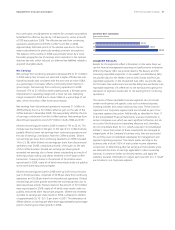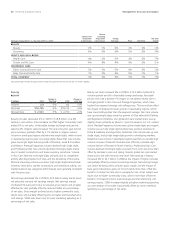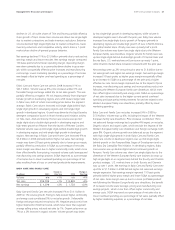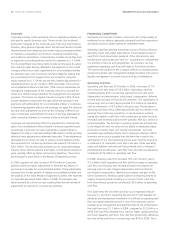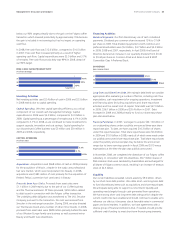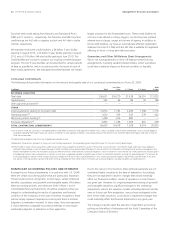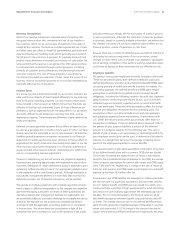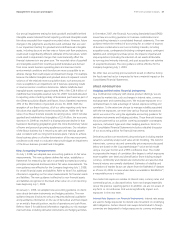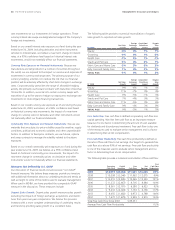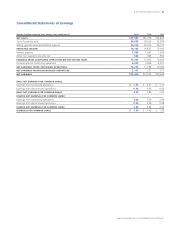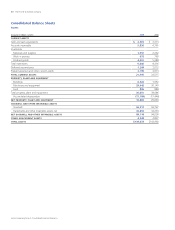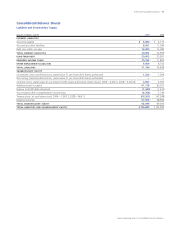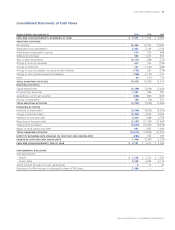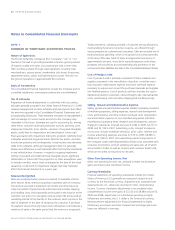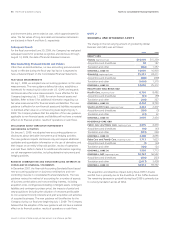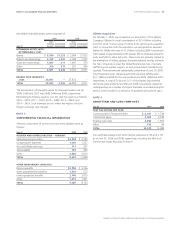Proctor and Gamble 2009 Annual Report Download - page 49
Download and view the complete annual report
Please find page 49 of the 2009 Proctor and Gamble annual report below. You can navigate through the pages in the report by either clicking on the pages listed below, or by using the keyword search tool below to find specific information within the annual report.Management’s Discussion and Analysis The Procter & Gamble Company 47
Our annual impairment testing for both goodwill and indefinite-lived
intangible assets indicated that all reporting units and intangible assets
fair values exceeded their respective recorded values. However, future
changes in the judgments, assumptions and estimates that are used
in our impairment testing for goodwill and indefinite-lived intangible
assets, including discount and tax rates or future cash flow projections,
could result in significantly different estimates of the fair values, which
could result in impairment charges that could materially affect the
financial statements in any given year. The recorded value of goodwill
and intangible assets from recently acquired businesses are derived
from more recent business operating plans and macroeconomic
environmental conditions and therefore are more susceptible to an
adverse change that could require an impairment charge. For example,
because the Gillette intangible and goodwill amounts represent current
values as of the relatively recent acquisition date, such amounts are
more susceptible to an impairment risk if business operating results
or macroeconomic conditions deteriorate. Gillette indefinite-lived
intangible assets represent approximately 89% of the $26.9billion of
indefinite-lived intangible assets at June 30, 2009. Goodwill allocated
to reporting units consisting entirely of businesses purchased as part of
the Gillette acquisition (Blades and Razors, Braun, Batteries) represents
47% of the $56.5billion of goodwill at June 30, 2009. With the
exception of our Braun business, all of our other reporting units have
fair values that significantly exceed recorded values. While the fair
value of our Braun business exceeds its carrying value, which includes
goodwill and indefinite-lived intangibles of $2.4billion, the economic
downturn in 2009 has resulted in a disproportionate decline in that
business in developing geographies given the more discretionary nature
of home and personal grooming appliances purchases. Our valuation
of the Braun business has it returning to sales and earnings growth
rates consistent with our long-term business plans. Failure to achieve
these business plans or a further deterioration of the macroeconomic
conditions could result in a valuation that would trigger an impairment
of the Braun business goodwill and intangibles.
New Accounting Pronouncements
On July 1, 2008, we adopted new accounting guidance on fair value
measurements. This new guidance defines fair value, establishes a
framework for measuring fair value in generally accepted accounting
principles and expands disclosures about fair value measurements. The
new guidance was effective for the Company beginning July1, 2008,
for certain financial assets and liabilities. Refer to Note 5 for additional
information regarding our fair value measurements for financial assets
and liabilities. The new guidance is effective for non-financial assets
and liabilities recognized or disclosed at fair value on a non-recurring
basis beginning July 1, 2009.
On January 1, 2009, we adopted new accounting guidance on disclo-
sures about derivative instruments and hedging activities. The new
guidance impacts disclosures only and requires additional qualitative
and quantitative information on the use of derivatives and their impact
on an entity’s financial position, results of operations and cash flows.
Refer to Note 5 for additional information regarding our risk manage-
ment activities, including derivative instruments and hedging activities.
In December2007, the Financial Accounting Standards Board (FASB)
issued new accounting guidance on business combinations and
noncontrolling interests in consolidated financial statements. The new
guidance revises the method of accounting for a number of aspects
of business combinations and noncontrolling interests, including
acquisition costs, contingencies (including contingent assets, contingent
liabilities and contingent purchase price), the impacts of partial and
step-acquisitions (including the valuation of net assets attributable
to non-acquired minority interests), and post acquisition exit activities
of acquired businesses. The new guidance will be effective for the
Company beginning July1, 2009.
No other new accounting pronouncement issued or effective during
the fiscal year has had or is expected to have a material impact on the
Consolidated Financial Statements.
OTHER INFORMATION
Hedging and Derivative Financial Instruments
As a multinational company with diverse product offerings, we are
exposed to market risks, such as changes in interest rates, currency
exchange rates and commodity prices. We evaluate exposures on a
centralized basis to take advantage of natural exposure netting and
correlation. To the extent we choose to manage volatility associated
with the net exposures, we enter into various financial transactions
which we account for using the applicable accounting guidance for
derivative instruments and hedging activities. These financial transac-
tions are governed by our policies covering acceptable counterparty
exposure, instrument types and other hedging practices. Note 5 to
the Consolidated Financial Statements includes a detailed discussion
of our accounting policies for financial instruments.
Derivative positions are monitored using techniques including market
valuation, sensitivity analysis and value-at-risk modeling. The tests for
interest rate, currency rate and commodity price exposures discussed
below are based on the CorporateManager™value-at-risk model
using a one-year horizon and a 95% confidence level. The model
incorporates the impact of correlation (the degree to which exposures
move together over time) and diversification (from holding multiple
currency, commodity and interest rate instruments) and assumes that
financial returns are normally distributed. Estimates of volatility and
correlations of market factors are drawn from the RiskMetrics™dataset
as of June 30, 2009. In cases where data is unavailable in RiskMetrics™,
a reasonable proxy is included.
Our market risk exposures relative to interest rates, currency rates and
commodity prices, as discussed below, have not changed materially
versus the previous reporting period. In addition, we are not aware of
any facts or circumstances that would significantly impact such
exposures in the near term.
Interest Rate Exposure on Financial Instruments. Interest rate swaps
are used to hedge exposures to interest rate movement on underlying
debt obligations. Certain interest rate swaps denominated in foreign
currencies are designated to hedge exposures to currency exchange


